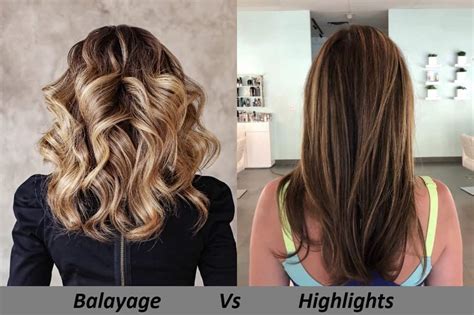Balayage and highlights are two popular hair coloring techniques that can add depth, dimension, and brightness to dark hair. While both methods involve lightening strands, they differ in their application and results. Understanding the nuances of each technique can help you make an informed decision on which one suits your desired look.

Balayage vs Highlights: Key Differences
| Feature | Balayage | Highlights |
|---|---|---|
| Application | Freehand painting | Foils or cap |
| Result | Gradual, blended transitions | Defined, contrasting streaks |
| Maintenance | Requires less touch-ups | Requires more frequent touch-ups |
| Cost | Generally more expensive | Generally less expensive |
| Best suited for | Gradual, natural-looking highlights | Defined, precise highlights |
Balayage: A Subtle, Sun-Kissed Look
Balayage, a French term meaning “to sweep,” involves freehand painting lightener onto selected sections of hair. The artist uses a brush to create soft, graduated transitions from root to tip. The resulting effect mimics natural sun-bleaching, offering a subtle, lived-in look.
According to a study by L’Oréal Professionnel, balayage is particularly flattering on dark hair because it adds warmth and dimension without overwhelming the base color. The gradual lightening process also reduces damage to the hair, making it a gentler option compared to traditional highlights.
Highlights: Defined, Contrasting Streaks
Highlights, on the other hand, create bolder, more defined streaks of color. The process involves isolating strands of hair and applying lightener using foils or a cap. This results in a more uniform, contrasting effect that can brighten the hair more significantly.
The market research firm Mintel reports that highlights remain a popular choice for women over 40, as they can help reduce the appearance of gray hair and create a more youthful look. However, highlights require more frequent touch-ups than balayage, as the roots tend to grow in more noticeably.
Which Technique Is Right for You?
The choice between balayage and highlights ultimately depends on your desired look and lifestyle. If you prefer a subtle, blended effect that requires less maintenance, balayage is an excellent option. However, if you want more defined, contrasting highlights, highlights may be a better choice.
To help you make the decision, consider the following factors:
- Hair Texture: Balayage is generally more suitable for coarse, thick hair, as it can help tame frizz and add volume. Highlights, on the other hand, can make fine hair look thinner.
- Lifestyle: Balayage requires less frequent touch-ups, making it a good option for those with busy schedules. Highlights, on the other hand, require more maintenance, so they may not be suitable for those who don’t have time for regular salon visits.
- Personal Style: Balayage tends to create a more bohemian, natural look, while highlights offer a more polished, glamorous effect. Choose the technique that best aligns with your personality and style goals.
Achieving Balayage and Highlights on Dark Hair
Balayage:
- Step 1: Section the hair into small sections.
- Step 2: Apply lightener to the mid-lengths and ends of the strands using a sweeping motion.
- Step 3: Allow the lightener to process for the specified amount of time.
- Step 4: Rinse and condition the hair.
Highlights:
- Step 1: Section the hair and isolate the strands to be highlighted.
- Step 2: Apply lightener to the desired sections using foils or a cap.
- Step 3: Wait for the lightener to process.
- Step 4: Remove the foils or cap and rinse the hair.
Tips for Choosing the Right Color
For both balayage and highlights, selecting the right color is crucial. For dark hair, the following tips can help you achieve the desired results:
- Consider Your Skin Tone: Warmer skin tones suit golden or reddish highlights, while cooler skin tones look better with ash or beige tones.
- Start Gradually: Begin with a few subtle highlights or a light balayage to test the color and avoid over-processing.
- Use a Gloss: Adding a gloss after the coloring process can enhance the shine and boost the color longevity.
Conclusion
Balayage and highlights are both excellent hair coloring techniques that can transform dark hair, adding depth, dimension, and brightness. While balayage offers a more natural, blended look, highlights provide bolder, contrasting streaks. Understanding the differences between the two techniques and considering your desired look, lifestyle, and hair type can help you make an informed decision on which method is right for you.
